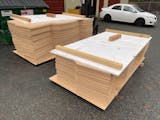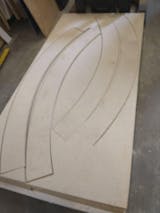The Three Practical Levels of CNC Router Bits

Forget the jargon. Here's your simplified path to picking the perfect router bit:
1. Perfect Top Surface? Go Down-Cut
When to use:
-
Engraving plywood or MDF veneers
-
Trimming delicate laminates
-
Cutting thin materials requiring a flawless top surface
Why it works:
Down-cut bits shear fibers downward, pressing material onto your spoilboard, minimizing tear-out and delivering an exceptional finish.
Tip: Keep passes shallow (around ¼ bit diameter) and feed rates moderate to avoid chip clogging.
Recommended Tool: SpeTool Down-Cut Spiral Bits
2. Deep Pockets or Mortises? Choose Up-Cut
When to use:
-
Mortise cutting
-
Deep slots or pockets
-
Fast roughing operations
Why it works:
Up-cut bits efficiently lift chips from the cut, allowing deeper passes and faster feed rates while reducing heat build-up.
Tip: Secure your workpiece well with vacuum tables, tabs, or tape-and-glue methods to counteract upward pull.
Recommended Tool: SpeTool Up-Cut Spiral Bits
3. Perfect Both Faces in One Pass? Compression’s Your Friend
When to use:
-
Cutting through plywood, melamine, or laminate sheets
-
Projects requiring clean finishes on both top and bottom
Why it works:
Compression bits blend up-cut and down-cut actions, compressing the material's layers toward the center. The result is smooth, splinter-free surfaces on both sides simultaneously.
Tool Comparison (Neutral Overview):
| Bit | Specs (CD × CL × Shank) | Approx. Price | Warranty/Coating |
|---|---|---|---|
| SpeTool W02003 | ¼" × 1" × ¼", 2-flute | $14.99 | 365-day, uncoated |
| Whiteside UD2102 | ¼" × 1" × ¼", 2-flute | $38.29 | Defect-only, uncoated |
| Amana 46170-K (Spektra) | ¼" × ⅞" × ¼", 2-flute | $72.19 | Spektra nano-coating |
Entry-priced bits like SpeTool's W02003 offer excellent value without sacrificing performance. Premium bits, such as Amana’s Spektra series, are ideal for high-volume shops needing maximum durability.
Your Simplified Decision Checklist:
-
Identify the key requirements: Top finish, chip evacuation, or dual-face quality?
-
Match your project to the bit type: Down-cut, up-cut, or compression.
-
Adjust feeds, speeds, and depths according to bit choice.
-
Test with scrap material first and adjust if needed.
This streamlined process eliminates guesswork, helping you achieve better results faster.
Author: Steve Yi
About the Author:
Steve Yi is the founder of SpeTool, a cross-border e-commerce brand specializing in high-precision CNC woodworking tools. With a background in data-driven product development and a love for hands-on craftsmanship, Steve translates workshop challenges into innovative router bits, sleds, and drill guides.






